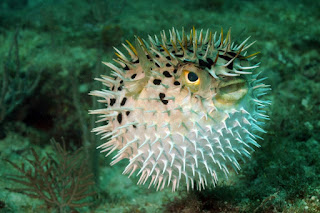
The pufferfish is an easily recognizable species of fish due to its ability to transform and enlarge its body in a fraction of a second. There are more than 120 species of pufferfish that mainly live in the warm waters of the Indian, Pacific, and Atlantic Oceans, with only 30 species living in freshwater. Some species migrate from the sea to brackish or fresh water during the breeding season. Although the numbers of pufferfish are stable in nature, they are at risk to overfishing, ocean pollution, and loss of natural habitats.
Puffer fish vary in size from one inch long pygmy puffer, to a two feet long freshwater giant puffer.
Despite of this risk, countries such as Korea, China and Japan consider puffer fish a culinary delicacy and only specially-trained chefs know how to serve them safely.
Main feature, common for all puffer fish, is ability to ingest huge amount of water (and air sometimes) which increases their body size and turn them into odd-looking ball-like creatures. Quick transformation scares predators.
Only 18 species have been recorded in the Maldives.
Scientists believe that puffer fish developed this tactic as a method of the self-defense because they are poor swimmers that cannot escape from the danger quickly.
The largest Puffer fish in Maldives is the Starry Puffer fish (Arothron stellatus) growing up to 1 m long.
Increase of the body size is not the only tactic used against the predators. Almost all species of puffer fish contain toxin (called tetrodotoxin) that can be 1200 times stronger than cyanide.
The smallest Puffer fish in Maldives is the White-spotted Puffer fish (Canthigaster janthinoptera) with a length of only 8 cm.
One puffer fish contains enough toxin to kill 30 adult men.
Puffer fish do not have scales. Their skin is thick and rough. Some species have spines on the skin, which offer additional protection against the predators.
Toxin is not located in all parts of the puffer fish, and certain cultures prepare puffer fish (meal called fugu in Japan) as a delicacy. Only specially trained chiefs can clean the fish properly and prepare delicious and toxin-free meal. Just one wrong cut of the fish meat can result in the death of the customer.
Because pufferfish are poor swimmers, they are more likely to get eaten by larger fish.
Sharks are the only species immune to the puffer fish’s toxin. They can eat puffer fish without any negative consequences.
The most elastic part of their body is the skin on the stomach area. When Puffer fish ingests water to puff up, the skin on the stomach expands several times of the normal size.
Puffer fish can be discretely or brightly colored. There is often relationship between the body coloration and the amount of toxin produced by the fish (brighter colors are often associated with large quantity of toxin in the fish).
Sharks are the only species immune to the Puffer fish’s toxin. They can eat this toxic fish without any negative consequences.
Puffer fish do not have scales. Their skin is thick and rough. Some species have spines on the skin, which offer additional protection against the predators.
Puffer fish have four teeth, two at the top and two at the bottom, both fused to look like one large tooth, making Puffer fish seem like they have beaks.
The most elastic part of their body is skin on the stomach area. When puffer fish ingests water, skin on the stomach expands several times of the normal size of the fish.
They use their teeth for opening mussels, clams and shellfish.
Puffer fish have four teeth that are fused in the beak-like structure. They use their teeth for opening of mussels, clams and shellfish. Puffer fish also eat algae and different types of worms and crustaceans.
Their teeth always keep on growing, so they need to feed on hard shells to help organically trim the teeth and keep them short.
Puffer fish have excellent eyesight.
The toxicity of puffer fish has been known since the Egyptian era some 3000–5000 years ago.
Puffer fish reach sexual maturity at the age of five. Male guides the female to the shallow water (close to the shore) where she will release (usually) between three to seven eggs. Young fish are protected by the hard egg shell that will crack as soon as they are ready to hatch. After leaving the egg, young puffer fish swim toward the reef’s community.
Puffer fish, porcupine fish, ocean sunfishes, and related species in the order Tetraodontiformes are frequently poisonous and may produce a severe neurologic illness following ingestion.
Although some baby puffer fish cannot be seen without magnifying glass, their body shape resembles those of the adult animals.
Most cases of pufferfish poisoning occur in Japan, where pufferfish or fugu is eaten as a very expensive and prized delicacy.
Average lifespan of the puffer fish is around 10 years.









